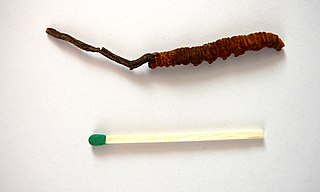
Ophiocordyceps sinensis, known colloquially as caterpillar fungus, is an entomopathogenic fungus in the family Ophiocordycipitaceae. It is mainly found in the meadows above 3,500 metres (11,500 ft) on the Tibetan Plateau in Tibet and the Himalayan regions of Bhutan and Nepal. It parasitizes larvae of ghost moths and produces a fruiting body which used to be valued as a herbal remedy in traditional Chinese medicine. Caterpillar fungus contains the compound cordycepin, an adenosine derivative. However, the fruiting bodies harvested in nature usually contain high amounts of arsenic and other heavy metals, so they are potentially toxic and sales have been strictly regulated by China's State Administration for Market Regulation since 2016.
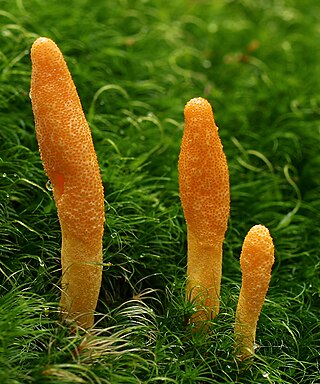
Cordyceps is a genus of ascomycete fungi that includes about 600 worldwide species. Diverse variants of cordyceps have had more than 1,500 years of use in Chinese medicine. Most Cordyceps species are endoparasitoids, parasitic mainly on insects and other arthropods ; a few are parasitic on other fungi.

The Hypocreales are an order of fungi within the class Sordariomycetes. In 2008, it was estimated that it contained some 237 genera, and 2647 species in seven families. Since then, a considerable number of further taxa have been identified, including an additional family, the Stachybotryaceae. Wijayawardene et al. in 2020 added more families and genera to the order. According to the Catalog of Life, As of April 2021 the Hypocreales contains 6 families, 137 genera, and 1411 species. Hyde et al. (2020a) listed 14 families under Hypocreales, while, Wijayawardene et al. (2022) accepted 15 families in the order, where Cylindriaceae was additionally added. Earlier, Hyde et al. (2020a) had placed Cylindriaceae in class Xylariomycetidae. Samarakoon et al. (2022) agreed. Hence, Cylindriaceae should have been excluded from Hypocreales and placed in Xylariomycetidae. Xiao et al. (2022) recently introduced a new family Polycephalomycetaceae to Hypocreales.
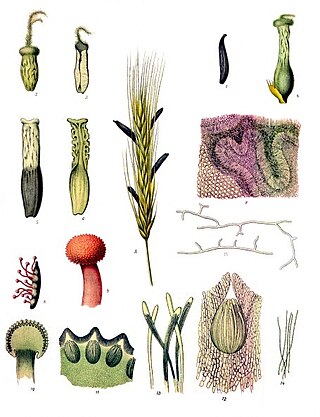
The Clavicipitaceae are a family of fungi within the order Hypocreales. A 2008 estimate placed 43 genera in the family, but a study in 2020 has increased this number to 50.

Beauveria is a genus of asexually-reproducing fungi allied with the ascomycete family Cordycipitaceae. Its several species are typically insect pathogens. The sexual states (teleomorphs) of Beauveria species, where known, are species of Cordyceps.

Metarhizium is a genus of entomopathogenic fungi in the Clavicipitaceae family. With the advent of genetic profiling, placing these fungi in proper taxa has now become possible. Most turn out to be the asexual forms (anamorphs) of fungi in the phylum Ascomycota, including Metacordyceps spp.
Hirsutella is a genus of asexually reproducing fungi in the Ophiocordycipitaceae family. Originally described by French mycologist Narcisse Théophile Patouillard in 1892, this genus includes species that are pathogens of insects, mites and nematodes; there is interest in the use of these fungi as biological controls of insect and nematode pests. The teleomorphs of Hirsutella species are thought to belong to the genus Ophiocordyceps.
Ascopolyporus is a genus of fungi within the family Cordycipitaceae. Species are pathogens of scale insects.

Metacordyceps is a genus of fungi in the family Clavicipitaceae. The anamorphs of Metacordyceps appear to include Metarhizium species.
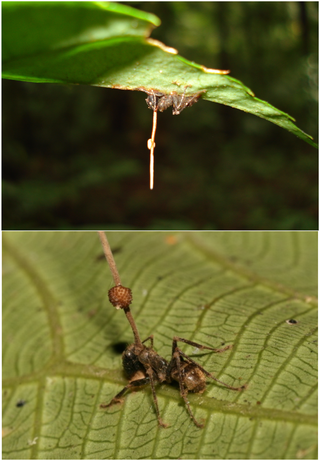
Ophiocordycipitaceae is a family of parasitic fungi in the Ascomycota, class Sordariomycetes. It was updated in 2020.

Lecanicillium lecanii is now an approved name of an entomopathogenic fungus species, that was previously widely known as Verticillium lecanii (Zimmerman) Viegas), but is now understood to be an anamorphic form in the Cordyceps group of genera in the Clavicipitaceae. Isolates formerly classified as V. lecanii could be L. attenuatum, L. lecanii, L. longisporum, L. muscarium or L. nodulosum. For example, several recent papers, such as Kouvelis et al. who carried out mitochondrial DNA studies, refer to the name L. muscarium.

Purpureocillium is a fungal genus in the Ophiocordycipitaceae family. The genus now contains at least 5 species with the type species Purpureocillium lilacinum, a common saprobic, filamentous fungus. It has been isolated from a wide range of habitats, including cultivated and uncultivated soils, forests, grassland, deserts, estuarine sediments and sewage sludge, and insects. It has also been found in nematode eggs, and occasionally from females of root-knot and cyst nematodes. In addition, it has frequently been detected in the rhizosphere of many crops. The species can grow at a wide range of temperatures – from 8 to 38 °C for a few isolates, with optimal growth in the range 26 to 30 °C. It also has a wide pH tolerance and can grow on a variety of substrates. P. lilacinum has shown promising results for use as a biocontrol agent to control the growth of destructive root-knot nematodes.
Hymenostilbe is a genus of fungi in the Ophiocordycipitaceae family. All members are anamorph names of Ophiocordyceps.
Paraisaria is a genus of fungi in the Ophiocordycipitaceae family. Members are anamorph names of Ophiocordyceps.
Syngliocladium is a genus of anamorphic fungi within the Ophiocordycipitaceae family. Members are anamorph names of Ophiocordyceps.
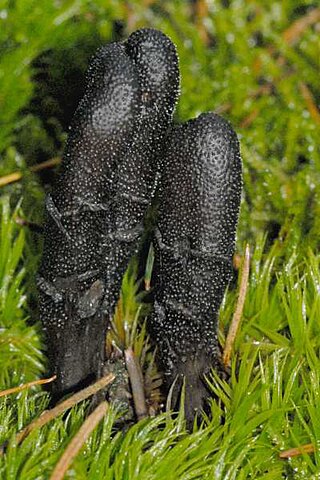
Tolypocladium ophioglossoides, also known by two of its better known synonyms Elaphocordyceps ophioglossoides and Cordyceps ophioglossoides and commonly known as the goldenthread cordyceps, is a species of fungus in the family Ophiocordycipitaceae. It is parasitic on fruit bodies of the truffle-like Elaphomyces. The specific epithet ophioglossoides, derived from Ancient Greek, means "like a snake's tongue". The species is thought to be inedible by people in the Western hemisphere, however, Traditional Chinese medicine of the Eastern Hemisphere recognizes T. ophioglossoides as a valuable medicinal fungi.

Cordyceps militaris is a species of fungus in the family Cordycipitaceae, and the type species of the genus Cordyceps. It was originally described by Carl Linnaeus in 1753 as Clavaria militaris.

Ophiocordyceps formicarum is an entomopathogenic fungus belonging to the order Hypocreales (Ascomycota) in the family Ophiocordycipitaceae. The fungus was first described by mycologist George S. Kobayashi in 1939 as a species of Cordyceps. Originally found in Japan growing on an adult Hercules ant, it was reported from Guizhou, China, in 2003. It was transferred to the new genus Ophiocordyceps in 2007 when the family Cordycipitaceae was reorganized. A technique has been developed to grow the fungus in an agar growth medium supplemented with yeast extract, inosine, and glucose.

Cordyceps locustiphila is the basionym and teleomorph of the fungi Beauveria locustiphila, a species of fungus in the family Cordycipitaceae. and is a species within the genus Cordyceps. It was originally described in by Henn in 1904. C. locustiphila is an entomopathogen and obligate parasite of the grasshopper species within the genus Colpolopha or Tropidacris, and as such is endemic to South America. The scientific name is derived from its close relationship with its host, being named after locusts. The fungi was renamed to Beauveria locustiphila in 2017 following research into the family Cordycipitaceae. Following the loss of the species type specimen, new studies were conducted that now recommend that the fungi be divided into 3 species. C. locustiphila, C. diapheromeriphila, and C. acridophila.

Cordyceps gunni is a species of fungus in the family Cordycipitaceae, and is of the genus Cordyceps. It was originally found and recorded by Gunn in Tasmania and named as Sphaeria gunnii and later moved into the Cordyceps genus and renamed Cordyceps gunnii. This fungus and its sisters in the genus Cordyceps are known for growing out of insect bodies. C. gunnii can be found at ground level poking out of caterpillar burrows, attached to a caterpillar's head.














